Exploring the Influence of AI on Logistics Trends in 2025

In the era of AI, artificial intelligence is transforming how the logistics industry operates. AI helps make operations smarter, safer, and more efficient. For example, AI-powered warehouses save 50% on costs and improve safety by 90%. By 2025, 62% of supply chain leaders want to use blockchain with AI. This will bring significant changes to logistics.
Key Takeaways
AI is changing logistics by making work faster and cheaper. Businesses can save half their costs and improve safety by 90% using AI tools.
Tools like generative AI and predictive analytics help plan better. They reduce mistakes in predictions by 20-50% and cut inventory costs by 5-10%.
Using AI tech like self-driving vehicles and smart cameras makes work easier. These tools bring quicker deliveries, save fuel, and make customers happier.
Key AI Trends in Logistics

Generative AI for supply chain innovation
Generative AI is changing how supply chains work. It helps make better decisions and solve problems faster. You can use it to predict trends, improve workflows, and fix sudden issues. About 40% of supply chain companies are already using generative AI. They mostly use it for managing knowledge. This tool makes operations smoother and more efficient. By 2025, generative AI will be a key part of logistics innovation.
Computer vision for real-time logistics monitoring
Computer vision is improving how logistics are tracked in real time. This AI tool uses images to follow shipments, check goods, and keep things safe. For example, it can identify objects with up to 99% accuracy. It also lowers insurance claims by 15% to 30%. The table below shows its benefits:
Improvement Area | Percentage Improvement |
|---|---|
Object identification accuracy | 50% to 99% |
Reduction in insurance claims | 15% to 30% |
Reduction in fuel costs | Up to 20% |
Improvement in driver behavior | Up to 75% |
These improvements make logistics more clear and efficient.
Predictive analytics for demand forecasting in the era of AI
Predictive analytics uses AI to study past data and predict future needs. This reduces mistakes and helps manage inventory better. For example, it can cut forecasting errors by 20% to 50%. It also lowers warehousing costs by 5% to 10%. The table below shows its advantages:
Metric | Improvement Percentage |
|---|---|
Reduction in forecasting errors | 20-50% |
Reduction in lost sales/product unavailability | Up to 65% |
Reduction in warehousing costs | 5-10% |
Reduction in administration expenses | 25-40% |
Using predictive analytics helps make smarter decisions and improves supply chains.
Autonomous vehicles and drones powered by artificial intelligence
Autonomous vehicles and drones are changing logistics by saving time and money. Self-driving trucks deliver goods over long distances. Drones are great for short-distance deliveries. These AI tools plan routes quickly and travel safely. They also process data fast, making deliveries quicker and more reliable. As these tools become common, logistics will get cheaper and more efficient.
Practical Uses of AI in Logistics
Smarter routes with AI for faster deliveries
AI has changed how deliveries are planned. It finds the best routes by studying traffic and weather. This saves fuel and cuts costs. For example:
AI helps companies deliver more packages each day.
It makes customers happy with on-time deliveries.
AI also improves on-time deliveries by 20% and shortens delivery times by 25%. These changes make supply chains work better.
JUSDA's smart warehouses and AI inventory tools
JUSDA uses AI to improve warehouse tasks. AI handles jobs like picking, packing, and tracking items. This reduces mistakes and saves time. The table below shows the benefits:
Feature | Details |
|---|---|
Task Automation | AI does jobs like tracking and packing, cutting errors. |
Better Inventory Accuracy | AI makes inventory tracking more precise. |
Improved Layouts | AI studies data to arrange warehouses better, saving space and time. |
JUSDA also uses sensors to find damaged goods and improve layouts. These tools make warehouses run smoother and faster.
Better customer help with AI chatbots
AI chatbots and virtual helpers make customer service quicker and easier. They answer questions anytime and solve problems faster. For example:
Benefit | Details |
|---|---|
Faster Replies | Chatbots reply to customer questions quickly. |
Problem Solving | They fix customer issues more often and faster. |
AI chats make customers more satisfied with the service. |
These tools give you helpful and personal support, making customers happier and more loyal.
Real-time updates with AI in logistics
AI gives live updates on where shipments are. It predicts delays and finds better routes to avoid problems. AI also automates tasks like scheduling and tracking. For example:
AI shows where your cargo is at all times.
It predicts and fixes possible delays.
Machine learning improves workflows for smooth operations.
Using AI helps you manage your supply chain better and make smarter choices.
Benefits of AI in Logistics
Saving money with AI automation
AI automation helps save money and boosts work efficiency. It finds better delivery routes, uses less fuel, and reduces manual work. For example, AI can cut transport costs by 22% and inventory costs by 30%. Companies recover their costs in one year and get 250% ROI in two years.
Outcome | Percentage Improvement |
|---|---|
Shorter delivery times | 25% |
More on-time deliveries | 20% |
Lower transport costs | 22% |
Reduced inventory costs | 30% |
Less manual labor costs | 35% |
Higher overall productivity | 12% |
AI makes work faster, saves money, and increases productivity.
Better predictions for inventory and demand
AI improves predictions by studying past data and finding patterns. Companies using AI see 20-50% lower inventory costs and 10-15% better forecasting. This helps avoid having too much or too little stock.
AI predicts demand better, so you don’t overstock.
It ensures products are ready when needed, keeping customers happy.
Using AI makes supply chains smoother and decisions smarter.
Happier customers with AI personalization
AI makes customers happier by offering services they need. Accurate forecasts ensure products are available, cutting lost sales by 65%. Chatbots and virtual helpers give 24/7 support, solving problems fast and building loyalty.
Evidence Type | Description |
|---|---|
AI-Driven Customer Service | AI uses data to improve loyalty and satisfaction. |
Chatbots and Virtual Assistants | These tools reply quickly and fix issues fast. |
Predictive Analytics | AI finds top customers and offers them deals. |
AI keeps customers updated and satisfied with real-time info.
Quicker decisions with real-time AI updates
AI gives live updates, helping you decide faster and smarter. It watches supply chains and warns about risks like delays. AI also finds better routes, saving time and cutting costs.
AI picks the best delivery routes, saving fuel and time.
It tracks operations live, helping you avoid problems.
With AI, you can solve issues fast and keep things running well.
Challenges and Risks in AI Adoption
Keeping data safe in AI logistics
AI in logistics uses a lot of data. This makes keeping it private and secure very important. Sharing customer and supplier details can lead to cyberattacks. Hackers target logistics because the data is valuable. To stay safe, use strong protections like encryption and access controls. Store data securely and dispose of it properly when done. Following rules like GDPR and CCPA adds extra steps but is necessary. Finding and fixing risks early keeps your data safe and follows the law.
Fair and ethical use of AI
Using AI in logistics brings up fairness questions. How can you make sure AI decisions are fair? Sometimes, AI might favor one shipment over another unfairly. It’s also important to know how AI makes its choices. This builds trust in the system. Another issue is the energy AI uses, which can harm the environment. Solving these problems ensures AI helps without breaking your values.
Training workers for AI changes
AI changes how logistics work by automating tasks. This can worry workers about losing jobs or learning new skills. To help, find out what skills they need and offer training. Teach them how to work with AI tools. Helping workers adapt makes them more comfortable with changes. This also keeps your operations running smoothly.
Managing high AI costs in logistics
Adding AI to logistics can be expensive. You need money for software, hardware, and skilled workers. In 2023, companies spent $154 billion on AI systems. Small businesses can save by starting with small projects that make a big difference. For example, Best Home Furnishings used AI to cut shipping costs and saved money. Planning carefully helps you spend wisely and still enjoy AI benefits.
Future Outlook for AI in Logistics
Long-term effects of AI on global supply chains
AI will change global supply chains by 2025. Spending on the Industrial Internet of Things (IIoT) will grow fast. It will rise from $1.67 billion in 2018 to $17.41 billion by 2025. This is a 40% yearly growth rate. These changes will make supply chains faster and more efficient. AI will help make decisions quicker and improve operations. By 2030, AI could add $15.7 trillion to the world economy.
Year | IIoT Spending (in Billion USD) | CAGR (%) |
|---|---|---|
2018 | 1.67 | N/A |
2025 | 17.41 | 40 |
These advancements will make supply chains stronger and more reliable.
Steps for using AI successfully in logistics
To use AI well, companies need clear strategies. AI can lower inventory costs by 20-50%. It also improves forecasting accuracy by 10-15%. Real-time data can make forecasts up to 50% better. Start small, like using AI for transport or inventory tasks. Slowly expand AI to other areas for bigger benefits.
Use AI tools to cut inventory costs.
Analyze real-time data for smarter decisions.
Pick AI solutions that can grow over time.
These steps help companies use AI smoothly and effectively.
JUSDA's impact on AI-powered logistics
JUSDA is leading in AI logistics solutions. Its tools save money and improve efficiency. Predictive maintenance lowers repair costs by 20-35%. It also makes vehicles last 15-25% longer. Real-time routing cuts delivery times by 15-25% and fuel use by 30%. Weather analytics improve accuracy by 40% and predict severe weather 50-60% better.
Application | Improvement Type | Quantifiable Result |
|---|---|---|
Predictive Maintenance | Maintenance Costs | Cut by 20-35% |
Vehicle Lifespan | Improve 15-25% | |
Weather Analytics | Impact Accuracy | Increase by 40% |
Severe Weather ID | 50-60% | |
Real-Time Routing | Delivery Times | Reduce by 15-25% |
Fuel Consumption | Decrease by 30% |
JUSDA’s work shows how AI can improve supply chains.
New technologies working with AI in logistics
New technologies are changing logistics. AI and IoT work together to process data quickly. Blockchain makes logistics safer and more open. Machine learning boosts efficiency, and AR/VR improves user experiences.
AI and IoT give real-time updates.
Blockchain adds safety and clarity to logistics.
Personalized deliveries make customers happier.
These tools work with AI to create new opportunities in logistics.

JUSDA Solutions
To provide you with professional solutions and quotations.
AI is changing logistics by making it better and smarter. By 2031, the AI supply chain market will reach $58.55 billion. Starting in 2024, it will grow by 40.4% each year. AI helps businesses save money and make better choices. To use AI wisely, be fair, clear, and responsible. It also helps create a greener future.
See Also
Unlocking AI's Hidden Power in Logistics and Supply Chains
Discovering AI's Role in Shaping Tomorrow's Supply Chain
Transforming Logistics for the Future with AI Innovations
Navigating Future Logistics Through Advanced Digital Solutions
Investigating Sustainable Robotics Trends in Supply Chain Operations
